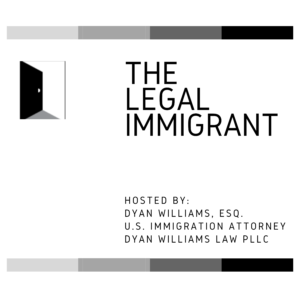 When you are physically present in the U.S., your filing for Adjustment of Status (AOS) allows you to become a permanent resident without needing to apply for an immigrant visa at the U.S. Consulate abroad.
When you are physically present in the U.S., your filing for Adjustment of Status (AOS) allows you to become a permanent resident without needing to apply for an immigrant visa at the U.S. Consulate abroad.
But if you are ineligible for AOS and mistakenly file a Form I-485, Application to Register Permanent Residence or Adjust Status, your request will not only be denied, but you may also be placed in removal proceedings due to failure to maintain lawful nonimmigrant status and/or other grounds.
General Adjustment of Status (AOS) Eligibility Requirements
Foreign nationals may file for adjustment to permanent resident status if they meet the eligibility requirements at the time of submitting their Form I-485 application to USCIS.
Who is generally ELIGIBLE for AOS?
Immigrant categories that permit AOS include:
Immediate relative of a U.S. citizen [spouses, unmarried children under 21 years of age, and parents (if the U.S. citizen is 21 years of age or older)]
Other relative of a U.S. citizen or relative of a lawful permanent resident under a family-based preference category (See U.S. Department of State’s Visa Bulletin for a list of family-based preference categories)
Person admitted to the United States on a K-1 visa as a fiancé(e) of a U.S. citizen and then marries the U.S. citizen. [A K-1 visa holder who enters a valid and bona fide marriage to the U.S. citizen petitioner within 90 days of arrival in the U.S. remains eligible to adjust status on that basis, even if the marriage is legally terminated (whether by death, dissolution, or divorce) prior to adjustment of status and regardless of whether he/she remarries thereafter.]
Widow(er) of a U.S. citizen
Violence Against Women Act (VAWA) self-petitioner
Foreign national worker under an employment-based preference category (See U.S. Department of State’s Visa Bulletin for list of employment-based preference categories)
Foreign national entrepreneur (EB5 immigrant employment-based category)
Special immigrant (includes religious workers, special immigrant juveniles, certain Afghans and Iraqis, certain U.S. armed forces members, certain physicians)
Certain victim of human trafficking (T nonimmigrant)
Certain victim of crime (U nonimmigrant)
Person granted asylum status
Person granted refugee status
Person selected in the Diversity Visa lottery program
Beneficiary of INA 245(i) benefits
Who is generally NOT ELIGIBLE for AOS?
With limited exceptions, foreign nationals who are barred from applying for AOS include:
Foreign national who last entered the United States without being inspected and admitted or paroled by an immigration officer. [INA 245(i) and VAWA-based applicants are exempt from this bar.]
Foreign national who was issued a C-1/D-1 or D-2 visa as a nonimmigrant crewman and last entered the United States as a crewman in pursuit of related employment. [VAWA-based applicants are exempt from this INA 245(c)(1) bar.]
Foreign national who is now employed or has ever been employed in the United States without authorization. [ Immediate relatives of a U.S. citizen, VAWA-based applicants, and certain special immigrants are exempt from these INA 245(c)(2) and INA 245 (c)(8) bars.]
Foreign national who is not in lawful immigration status on the date of filing the Form I-485 application. [Immediate relatives of a U.S. citizen, VAWA-based applicants, and certain special immigrants are exempt from this INA 245(c)(2) bar.]
Foreign national who has ever failed to continuously maintain a lawful status since entry into the United States, unless the failure to maintain status was through no fault of his or her own or for technical reasons. [Immediate relatives of a U.S. citizen, VAWA-based applicants, and certain special immigrants are exempt from this INA 245(c)(2) bar.]
Foreign national who was last admitted to the United States in transit without a visa. [VAWA-based applicants are exempt from this INA 245(c)(3) bar.]
Foreign national who was last admitted to Guam or the Commonwealth of the Northern Mariana Islands (CNMI) as a visitor under the Guam or CNMI Visa Waiver Program and who is not a Canadian citizen. [Immediate relatives of a U.S. citizens are exempt from this bar.]
Foreign national who was last admitted to the United States as a nonimmigrant visitor without a visa under the Visa Waiver Program. [Immediate relatives of a U.S. citizens and VAWA-based applicants are exempt from this INA 245(c) bar.]
Foreign national who is deportable due to involvement in a terrorist activity or group. [VAWA-based applicants are exempt from this INA 245(c)(6) bar, but may still be inadmissible for such activity.]
Foreign national who is seeking employment-based adjustment of status and who is not maintaining a lawful nonimmigrant status on the date of filing this application. [In some cases, the INA 245(k) exemption excuses this INA 245(c)(7) bar.]
Foreign national who has ever violated the terms of the nonimmigrant status. [Immediate relatives of a U.S. citizen, VAWA-based applicants, and certain special immigrants are exempt from this INA 245(c)(8) bar.]
Foreign national who is a conditional permanent resident. [Conditional permanent residents must instead file a Form I-751 petition to remove conditions on their status to obtain permanent residence unconditionally.]
Foreign national who was admitted to the U.S. on a K-1 nonimmigrant fiancé(e) visa, but did not marry the U.S. citizen who filed the petition or foreign national who was admitted as the K-2 nonimmigrant child of a fiancé(e) whose parent did not marry the U.S. citizen who filed the petition.
INA 245(a) Adjustment of Status (AOS) Eligibility Requirements
Most applicants file for Adjustment of Status based on INA 245(a), which includes beneficiaries of family-based I-130 petitions and beneficiaries of employment-based I-140 petitions.
INA 245(a) does not include all the possible ways of adjusting status, such as AOS of Refugees or Asylees under INA 209(b), AOS of T nonimmigrants under INA 245(l), and AOS of U nonimmigrants under INA 245(m).
The AOS eligibility requirements under section 245(a) include:
1. You must normally have been inspected and admitted into the United States; or inspected and paroled into the United States.
To lawfully enter the United States, you must first present yourself for inspection to an immigration officer at a U.S. port of entry.
Unless you are an INA 245(i) applicant or a Violence Against Women Act (VAWA) applicant, you must meet the Inspected and Admitted or Paroled Requirement to qualify for AOS under section 245(a).
Although INA § 245(i) generally allows a person to adjust status despite unlawful entry to the U.S., it does not necessarily waive every ground of inadmissibility, such as INA 212(a)(9)(C), i.e. illegal re-entry to the U.S. following a removal order or accrual of unlawful presence lasting one year or more, on or after April 1, 1997. Even if a person otherwise qualifies for section 245(i) benefits, he is not eligible for AOS when the permanent bar under section 212(a)(9)(C) applies.
Admission
For lawful admission to occur, the immigration officer must authorize you to enter the U.S. in accordance with the procedures for admission. If, however, the admission was based on a false claim to U.S. citizenship or to U.S. nationality at the port of entry, the lawful admission requirement is not met.
The most common documents showing lawful admission are:
Arrival/Departure Record (Form I-94)
Admission stamp in passport, which may be verified using Department of Homeland Security (DHS) systems
Employment Authorization Card (Form I-688A), for special agricultural worker applicants, provided it was valid during the last claimed date of entry on the adjustment application
Temporary Resident Card (Form I-688), for special agricultural workers or legalization applicants granted temporary residence, provided it was valid during the last claimed date of entry on the adjustment application
Border Crossing Card (Form I-586 or Form DSP-150), provided it was valid on the date of last claimed entry.
Plane tickets evidencing travel to the United States, or other corroborating evidence, when an Arrival/Departure Record is not required in the following situations:
- a Canadian citizen admitted as a visitor for business, visitor for pleasure, or who was permitted to directly transit through the United States;
- a nonimmigrant residing in the British Virgin Islands who was admitted only to the U.S. Virgin Islands as a visitor for business or pleasure;
- a Mexican national admitted with a B-1/B-2 Visa and Border Crossing Card (Form DSP-150) at a land or sea port of entry as a visitor for business or pleasure for a period of 30 days to travel within 25 miles of the border;
- a Mexican national in possession of a Mexican diplomatic or official passport.
Waved through at port of entry
A wave through is when you present yourself for inspection, but the inspector waves you through the U.S.-Mexico or U.S-Canada land border, and allows you to enter the U.S. without asking any questions or checking your travel documents. You must present a credible claim and submit supporting evidence, such as third party affidavits from those with personal knowledge about your wave through admission.
Parole
In some situations, you may receive a grant of parole to enter the U.S. This is a temporary, discretionary act and is not an admission. Without determining whether you may be admitted to the U.S., the immigration officer may parole you in for deferred inspection or due to urgent humanitarian reasons or significant public benefits.
Parole in Place may also be issued to certain foreign nationals present without admission or parole, such as to a spouse, child, or parent of an active duty member of the U.S. armed forces, a member in the Selected Reserve of the Ready Reserve, or someone who previously served in the U.S. armed forces or the Selected Reserve of the Ready Reserve.
2. You must properly file an adjustment of status application.
The Form I-485 must be filed with USCIS in accordance with the form instructions, when you are physically present in the United States. It must be signed, accompanied by the proper filing fee (unless a fee waiver is granted), submitted at the correct filing location, and filed when the priority date is current.
3. You must be eligible to receive an immigrant visa and an immigrant visa must be available when you file the adjustment of status applicationand at the time of final adjudication.
Eligibility for an immigrant visa depends on the immigrant category in which you are filing for adjustment. Except for the Immediate Relative of a U.S. citizen category, the family-based and employment-based categories typically require a wait (sometimes for years or decades) before an immigrant visa becomes available.
4. You must be admissible to the United States for lawful permanent residence or eligible for a waiver of inadmissibility or other form of relief.
You are ineligible for adjustment if you are subject to any inadmissibility grounds listed under INA 212, such as certain criminal offenses , fraud or willful misrepresentation of material facts to gain immigration benefits and unlawful presence. A waiver must be available and you must qualify for the waiver if you are inadmissible to the U.S.
5. You must merit the favorable exercise of discretion.
The approval of a Form I-485 application under certain categories, including INA 245(a) Adjustment, is a discretionary decision. This means you are not entitled to adjustment even when you are eligible for it.
Besides evaluating your eligibility, the immigration officer also considers other factors such as your immigration status and history; family unity; length of residence in the United States; business and employment; and community standing and moral character.
Statutory Bars to Adjusting Status Under INA 245(a)
Bars to adjusting status include unlawful immigration status at the time of filing a Form I-485 (INA 245(c)(2) bar); status and nonimmigrant visa violations (INA 245c)(2) and INA 245(c)(2)(8) bars); and failure to maintain lawful nonimmigrant status when you would otherwise be eligible for employment-based immigration (INA 245(c)(7) bar). There are, however, exceptions and exemptions.
Consult an Experienced Immigration Attorney
Because there are various bars and inadmissibility grounds to prevent AOS, as well as exemptions and waivers available, you need to consult an immigration attorney before you file a Form I-485 application to adjust to permanent resident status.
To learn more, read our related article, Adjusting to Permanent Resident Status Under INA 245(a): Bars, Exceptions and Exemptions.
# # #
This article provides general information only. It is based on law, regulations and policy that are subject to change. Do not consider it as legal advice for any individual case or situation. Each legal case is different and case examples do not constitute a prediction or guarantee of success or failure in any other case. The sharing or receipt of this information does not create an attorney-client relationship.



 When you are physically present in the U.S., your filing for Adjustment of Status (AOS) allows you to become a permanent resident without needing to apply for an immigrant visa at the U.S. Consulate abroad.
When you are physically present in the U.S., your filing for Adjustment of Status (AOS) allows you to become a permanent resident without needing to apply for an immigrant visa at the U.S. Consulate abroad.